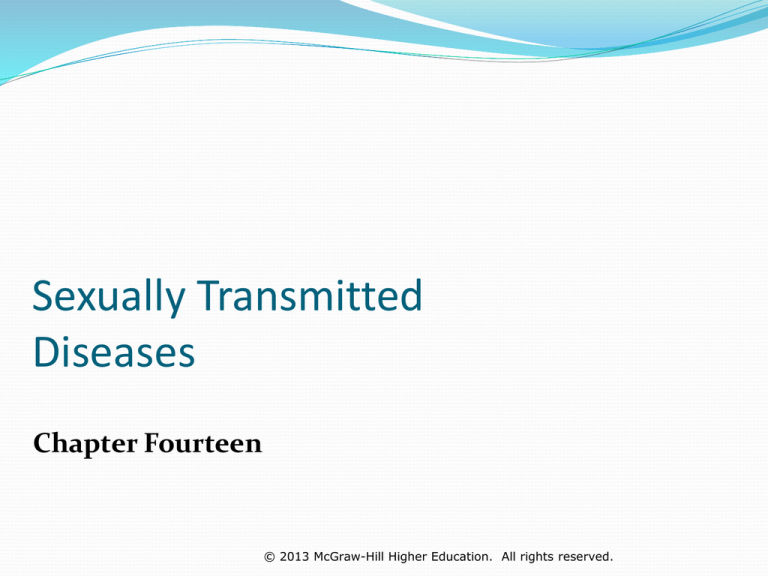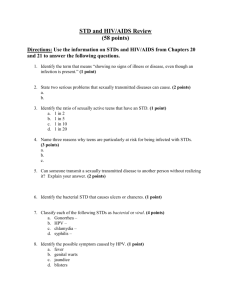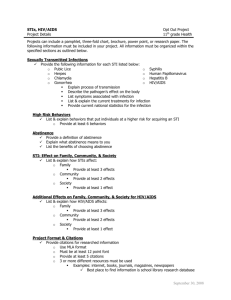
Sexually Transmitted
Diseases
Chapter Fourteen
© 2013 McGraw-Hill Higher Education. All rights reserved.
The Major Sexually Transmitted
Diseases
Also known as sexually transmitted infections
The Major STDs (STIs)
HIV/AIDS
Chlamydia
Gonorrhea
Human papillomavirus
Genital warts (HPV)
Genital herpes
Hepatitis B
Syphilis
© 2013 McGraw-Hill Higher Education. All rights reserved.
2
Annual New Cases of STDs in the
United States
© 2013 McGraw-Hill Higher Education. All rights reserved.
3
HIV Infection and AIDS
About 1.1 million Americans are believed to currently be
living with HIV, and about 56,000 new infections were
reported in 2006
HIV infection is a chronic, progressive disease that
damages the immune system
AIDS, Acquired Immunodeficiency Syndrome, is a
generally incurable sexually transmitted viral disease that
ultimately kills most of its victims; severe stage of HIV
infection
The destruction of the immune system begins with the loss
of CD4 T cells (see Figure 14.1)
As the number of these T cells drop below 200/µl, this
becomes the marker for AIDS
© 2013 McGraw-Hill Higher Education. All rights reserved.
4
Routes of HIV Transmission
among Americans
© 2013 McGraw-Hill Higher Education. All rights reserved.
5
Transmitting the Virus
HIV lives only within the cells and body
fluids, not outside the body
The 3 main routes of HIV transmission are:
Specific kinds of sexual contact
Direct exposure to infected blood
Contact between HIV-infected mother and her
child during pregnancy, childbirth, or
breastfeeding
© 2013 McGraw-Hill Higher Education. All rights reserved.
6
HIV Infection: Symptoms
Flu-like symptoms of acute HIV infection may occur within a
few days or weeks of infection
Since these symptoms are similar to common viral illnesses,
the condition goes undiagnosed many times
Opportunistic infections occur later as the immune system
weakens
Pneumocystis carinii pneumonia
Kaposi’s sarcoma
Frequent and difficult-to-treat vaginal yeast infections
Tuberculosis
© 2013 McGraw-Hill Higher Education. All rights reserved.
7
HIV Infection and AIDS: Diagnosis
HIV antibody test detects the presence of antibodies to
HIV, indicating infection
ELISA = first stage of test
Western blot = confirmatory test
HIV Replication Capacity
Blood, urine, or oral fluid; rapid tests are available
May take up to 6 months following infection for antibodies
to appear
HIV RNA assay measures the amount of the HIV virus in
the blood; used to detect HIV infection in the earliest
stages and to track the status of the infection
© 2013 McGraw-Hill Higher Education. All rights reserved.
8
HIV Infection and AIDS: Treatment
There is no known cure for HIV infection or AIDS
Many drugs can significantly alter the course of the
disease, such as:
Antiviral drugs
Reverse transcriptase inhibitors
Protease inhibitors
Integrase inhibitors
Entry inhibitors
© 2013 McGraw-Hill Higher Education. All rights reserved.
9
HIV Infection and AIDS: Prevention
Abstinence is the only truly safe
option, unless you are in a longterm monogamous relationship
with an uninfected partner
Don’t drink or use drugs in sexual
situations
Limit the number of partners,
especially those who have engaged
in risky behavior; remember that
many people are not truthful about
their sexual history
Use latex condoms correctly during
every act of intercourse and oral sex
Avoid sexual contact that could cause
cuts or tears
Don’t share needles, syringes, or
anything that could have blood on it
Get screened, get tested, get vaccinated
for hepatitis B
© 2013 McGraw-Hill Higher Education. All rights reserved.
10
What’s Risky and What’s not…
© 2013 McGraw-Hill Higher Education. All rights reserved.
11
Chlamydia
Chlamydia trachomatis causes chlamydia, a prevalent
bacterial STD in the United States
Can cause PID, infertility, epididymitis, urethritis
Symptoms are very few:
Males: painful urination, a slight watery discharge, and
sometimes pain around the testicles
Women: increased vaginal discharge, burning with urination,
pain or bleeding with intercourse, and lower abdominal pain
Diagnosed with urine or lab tests
Treated with antibiotics
© 2013 McGraw-Hill Higher Education. All rights reserved.
12
Gonorrhea
Caused by the bacterium Neisseria gonorrhoeae which affects
mucous membranes
Can cause PID, infertility, epididymitis, urethritis, rashes,
arthritis; in infants, it can cause the serious eye infection
gonococcal conjunctivitis
Often asymptomatic in women; in men, it causes urinary
discomfort and penile discharge
Diagnosed with urine or lab tests
Treated with antibiotics; however, many strains are resistant
© 2013 McGraw-Hill Higher Education. All rights reserved.
13
Pelvic Inflammatory Disease (PID)
PID is an infection that progresses from the vagina and cervix
to the uterus, oviducts, and pelvic cavity
Common following untreated cases of gonorrhea or chlamydia
It is a leading cause of infertility in young women; also
increases risk of ectopic pregnancy and chronic pelvic pain
Symptoms vary greatly
Treated with antibiotics; however, may require hospitalization
© 2013 McGraw-Hill Higher Education. All rights reserved.
14
Human Papillomavirus Infection
HPV, human papillomavirus, causes several human diseases
including genital warts and genital cancers
HPV is one of the most common STDs in the United States,
especially with young people
Symptoms of infected tissue may appear normal or may have
obvious bumps or growths
Treatment does not eliminate the infection but focuses on
reducing the number and size of warts
In 2006, the FDA approved vaccine for HPV (Gardasil) and in
2009 (Carvarix)
© 2013 McGraw-Hill Higher Education. All rights reserved.
15
Genital Herpes
Persistent viral infection affecting about one in five American
adults
Two herpes simplex viruses are of great concern:
HSV-1 usually causes cold sores
HSV-2 usually causes genital herpes
Symptoms are recurrent outbreaks of painful genital lesions;
often asymptomatic in the beginning stages
Diagnosed from symptoms or blood test
Treatment with antiviral drugs can reduce the frequency and
severity of outbreaks; the virus remains in the body and can be
transmitted even if no lesions are present
© 2013 McGraw-Hill Higher Education. All rights reserved.
16
Hepatitis B
Hepatitis, inflammation of the liver, can cause permanent damage to
the liver and death
Hepatitis B virus (HBV) can be transmitted sexually and through close
nonsexual contact
Symptoms may include:
Flu-like illness
Nausea
Vomiting
Dark-colored urine
Abdominal pain
Jaundice
Diagnosed with blood tests through analysis of liver function
There is no cure, but a vaccine is available and safe to use
© 2013 McGraw-Hill Higher Education. All rights reserved.
17
Syphilis
Syphilis, a bacterium caused by the spirochete Treponema pallidum, can
be potentially fatal if not treated
Symptoms are different stages of infection:
Primary syphilis causes an ulcer called a chancre
Secondary syphilis develops flu-like symptoms and a skin rash
Late, or tertiary, syphilis becomes asymptomatic or symptoms
of severe organ damage, possibly leading to eventual death
Diagnosed by examination of infected tissue
and with blood tests
Treated with antibiotics
© 2013 McGraw-Hill Higher Education. All rights reserved.
18
Other STDs
Trichomoniasis, aka ‘Trich’
Single-celled organism
Bacterial vaginosis (BV)
Most common cause of abnormal vaginal discharge
Pubic lice (crabs) and scabies
Highly contagious parasitic infections
© 2013 McGraw-Hill Higher Education. All rights reserved.
19
What You Can Do About STDs
Education
Diagnosis and treatment
Prevention
Abstain
Mutually monogamous relationship with one
uninfected partner
Plan ahead for and practice safer sex
© 2013 McGraw-Hill Higher Education. All rights reserved.
20
Sexually Transmitted
Diseases
Chapter Fourteen
© 2013 McGraw-Hill Higher Education. All rights reserved.






